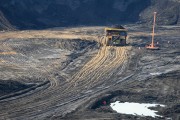Earlier this month, the Canada West Foundation published the results of an online survey that measured levels of public support for the largest economic sectors in western Canada — and the results should concern anyone interested in taking a more socially responsible approach to energy development.
The survey found that while western Canadians recognize the importance of the energy sector to the economy, there remains a high level of distrust of the oil and gas industry. The poll links this lack of trust to the view that the industry is only motivated by profit, and lacks social and environmental responsibility.
 Social and environmental responsibility is a key part of building public acceptance and confidence and is no easy task. It requires “walking the talk,” as well as getting out of the office and into the places where real people are having real conversations about how energy development affects them. From pipelines, and oilsands to fracking, earning the public’s trust is tied to meaningful dialogue and then action that effectively addresses concerns.
Social and environmental responsibility is a key part of building public acceptance and confidence and is no easy task. It requires “walking the talk,” as well as getting out of the office and into the places where real people are having real conversations about how energy development affects them. From pipelines, and oilsands to fracking, earning the public’s trust is tied to meaningful dialogue and then action that effectively addresses concerns.
Fostering effective consultation is an essential step toward establishing that trust. As energy companies (and even governments) continue to dedicate significant resources to talking ‘at’ Canadians through advertising campaigns, they’re missing the opportunity to focus their resources on listening to Canadians’ concerns and delivering a broader suite of sustainable actions the public expects from the energy sector.
At the Pembina Institute, we recently explored lessons learned from consultation processes for carbon capture and storage (CCS) projects — CCS is an innovative technological approach to managing greenhouse gas emissions that can sometimes be regarded with hesitation or scepticism among the public. What we learned can be applied to any kind of energy development and is especially useful for developers of sources of oil and gas that use new or unknown technologies and approaches.
So what are the hallmarks of effective public consultation? Here’s an overview of what we learned:

GO BEYOND REGULATIONS
Regulatory requirements are a bare minimum — public expectations are often higher.
DEDICATE RESOURCES
Create a complete team dedicated to engaging stakeholders that includes on-the-ground staff all the way up to to the CEO.
DEFINE SUCCESS
Success must be defined in collaboration with the public. Recognize that the community may choose not to support the project at the end of the consultation process, and that is a valid outcome.
BE FLEXIBLE
Start by listening to concerns and discussing them — there are no textbook answers.
CREATE A SAFE SPACE TO TALK
To receive honest feedback, create an environment where people feel they have a voice.
THINK LOCAL
Work to understand what's at the heart of concerns and build mutual benefits into project design.
EMPOWER
Be honest, share all the information, give stakeholders a voice, and trust their knowledge and experience.
CREATE AND SUSTAIN TRUST
All activities of an engagement must work towards building and maintaining trust.
For further details on the above steps for designing effective public engagement for energy projects, download the "lessons learned" fact sheet or CCS case studies.






